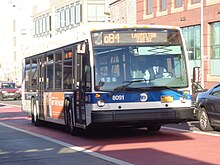Bus lanes in New York City
Since 1963, New York City has been using a system of bus lanes that are intended to give priority to buses, which contain more occupants than passenger and commercial vehicles.
The lanes are generally used to speed up MTA bus routes on the city's public transport system, which would be otherwise held up by traffic congestion.
[3] A busway typically allows buses and trucks to travel along the corridor, while also permitting local access via side streets for all other vehicles.
As early as 1959, the city wished to build exclusive bus lanes on Lafayette and DeKalb Avenues in Brooklyn.
One set of bus lanes was placed on Victory Boulevard in Staten Island, at the approach to the Saint George Ferry Terminal.
[8]: 7 On May 26, 1981, the New York City Department of Transportation (NYCDOT) implemented Commissioner Sam Schwartz's plan for bus lanes on Madison Avenue.
Another federal grant of $575,000 allowed the city to hire 22 traffic agents to enforce bus lane rules.
[11] In 1982, the city started a pilot project in which it installed red thermoplastic strips along 10 bus lanes in Manhattan.
[14]: 2–3 As a result of the study, three brands of red paint were determined to be suitable for use on New York City bus lanes.
[15][16] On April 18, 2019, de Blasio unveiled the Better Buses Action Plan, which recommended 24 locations where changes to speed up bus service should be made.
[22][23] While the Jay Street busway was implemented in September 2020,[24][25] none of the other projects were completed by that October, which had been the deadline set by de Blasio.
[29] By mid-2024, The New York Times estimated that fewer than 30 miles (48 km) of additional bus lanes would have been added in Adams's first three years.
Southbound Broadway contains a bus lane between Bowling Green and Houston Street, which carries the M55 and Staten Island express routes.
The southbound bus lane on 11th Avenue between 37th and 42nd Streets serves buses entering the Jacob K. Javits Convention Center, as well as the M12 route.
The other is in northern Harlem, along Convent Avenue between 135th and 145th Streets carry school buses, which headed for the City College of New York.
[34][62] A longer set of bus lanes in northern Jamaica, on Hillside Avenue between Merrick and Francis Lewis Boulevards, carry the Q1, Q36, and Q43.
[23] North–south lanes in Queens run along Main Street between Northern Boulevard and Horace Harding Expressway, hosting the Q20A/B and Q44 SBS as well as numerous routes terminating or passing through Downtown Flushing.
[62][63][64] Within Downtown Flushing, southbound traffic on Main Street between 37th Avenue and 40th Road is restricted to buses and local deliveries.
In March 2018, the NYCDOT announced that a short bus lane for the Q60 would be installed as part of the capital reconstruction of Queens Boulevard for Vision Zero's Great Streets program.
[34][76] One block south of Fulton are the Livingston Street bus lanes, which run between Boerum Place and Flatbush Avenue.
On eastbound Oriental Boulevard between Jaffrey and Norfolk Streets in Sheepshead Bay, a bus lane for Kingsborough Community College serves the B1 and B49 routes.
Hylan Boulevard's bus lanes host the S78, S79 SBS, and numerous express routes between Steuben Street and Lincoln Avenue.
[2] In 2010, the city gained authorization from the state to begin placing hidden traffic cameras on gantries above the bus lanes.
[103] Automated cameras rarely make errors, are not disputable, allow the police to respond to important issues, and add revenue to the city without the cost of human officers.
[106][107] The New York City Police Department launched a task force in December 2023 to ticket and tow vehicles that block bus lanes.
[110] Prior to installing the bus lane cameras, there were disputes between the MTA and the City of New York over who will get the revenue from the tickets.
[104] In one instance a camera issued nearly 7,200 violations in a two-month period, translating to an average of 115 tickets a day, and raising about $823,000 in fine revenue.
[115] The cameras allow for a temporary stop to pick up/drop off passengers at curbside bus lanes, but cab drivers are concerned that customers may take longer than usual to arrange payment, which may result in a fine.
[93] The installation of bus lanes reduced the amount of on-street parking in some areas, in turn potentially forcing the closures of businesses.
[116] According to one commentator for The New York Times, this did not serve the purpose of the cameras, which were to educate drivers and keep the bus lanes empty of cars.






